Intel’s 11th Gen Core Tiger Lake SoC Detailed: SuperFin, Willow Cove and Xe-LP
by Dr. Ian Cutress on August 13, 2020 9:01 AM EST- Posted in
- CPUs
- Intel
- SoCs
- Tiger Lake
- 10+
- Xe-LP
- Willow Cove
- Intel Arch Day 2020
- SuperFin
- 10SF
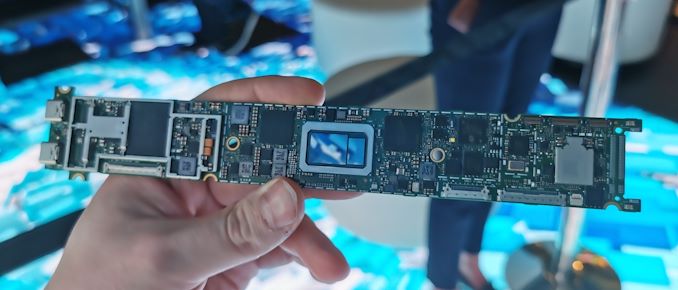
At the start of the year, Intel ‘foolishly’ handed me a wafer of its next generation Tiger Lake processors, as the moment it came into my hands I attempted to make a very quick exit. In my time with the wafer, we learned that this new 10nm laptop-focused processor had four cores, used Intel’s next generation Xe graphics architecture, and would set the stage at the end of the year as the cornerstone of Intel’s mobile processor offerings. As part of Intel’s Architecture Day 2020 a couple of days ago, the company went into detail about what makes Tiger Lake the true vehicle for 10nm, and why customers will want a Tiger Lake device.
Intel Architecture Day 2020, August 11th
Before we start into the information about Tiger Lake, I want to start by saying that the information in this article, as well as our coverage on Xe graphics and a number of upcoming mini-stories, all stems from Intel’s Architecture Day 2020 event. Building upon the success of the event in 2018, press and enthusiasts alike have continually asked when Intel would be doing it again. No doubt trying to pin down 20+ senior engineers and executives for an event at the same time in the same location is tough, and due to COVID this event was delayed at least twice.
Despite this, Intel made Arch Day 2020 a virtual event, allowing the engineers to pre-record their segments. The event was held behind closed doors, as with the 2018 event, the embargo lift was set for 1-2 days after. As a result, the articles you see published today are at the end of a lack of sleep between the event and now, as Intel went very dense very quickly (that’s a good thing™). We’ve digested as much as we can in that short space of time, we’ve asked some initial questions, but no doubt more will be asked as further analysis occurs.
The event was headlined by an effervescent Raja Koduri, who took the role of covering roadmaps and some of the Xe structural details. Prominent Intel Fellows and Engineers were the stars of the show in my eyes, particularly Ruth Brain (transistors), Ramune Nagisetty (packaging), Boyd Phelps (Tiger Lake), David Blythe (Xe GPU), Lisa Pierce (GPU software), Sailesh Kottapalli (Xeon) and others, all covering aspects of Intel’s strategy and portfolio.
Along with this article today covering Tiger Lake, we have an article going into the Xe graphics disclosures today as well. There are a number of mini-highlights from the event I also want to cover, and these will be published over the next few days.
Intel’s 11th Gen Core Tiger Lake SoC Detailed: Willow Cove and Xe-LP
Timeline: Tiger Lake will be Intel’s 11th Gen Core
Intel first unveiled its Core microarchitecture in Q1 2006, as an offshoot of the more power efficient Pentium Pro products. This was decided because the leading edge Intel products of the day, based on Netburst, were fast but hot and power hungry. By going down the route of Core, starting with Conroe, Intel has delivered multiple generations of products with the goal at each step to improve performance, power efficiency, and introduce better ways to perform compute.
| Intel's Core Family | |||||
| Gen | Year | Process | Core | Graphics | SoC |
| 1st Gen Core | 2006 | 65nm | Conroe | - | Core 2 |
| 2008 | 45nm | Nehalem | - | Lynnfield | |
| 2010 | 32nm | Westmere | Gen5 | Clarkdale | |
| 2nd Gen Core | 2011 | 32nm | Sandy Bridge | Gen6 | Sandy Bridge |
| 3rd Gen Core | 2012 | 22nm | Ivy Bridge | Gen7 | Ivy Bridge |
| 4th Gen Core | 2013 | 22nm | Haswell | Gen7.5 | Haswell |
| 5th Gen Core | 2015 | 14nm | Broadwell | Gen8 | Broadwell |
| 6th Gen Core | 2015 | 14nm | Skylake | Gen9 | Skylake |
| 7th Gen Core | 2017 | 14+ | Kaby Lake | Gen9 LP | Kaby Lake |
| 8th Gen Core | 2017 | 14++ | Coffee Lake | Gen9 LP | Coffee Lake |
| 2017 | 10 minus | Palm Cove | Gen10* | Cannon Lake | |
| 2018 | 14++ | Whiskey Lake | Gen9 LP | Whiskey Lake | |
| 2019 | 14+ | Amber Lake | Gen9 LP | Amber Lake | |
| 9th Gen Core | 2018 | 14++ | Coffee Lake | Gen9 LP | Coffee Lake-R |
| 10th Gen Core | 2019 | 14+++ | Comet Lake | Gen9 | Comet Lake |
| 2019 | 10nm | Sunny Cove | Gen11 | Ice Lake | |
| 11th Gen Core | 2020 | 10SF | Willow Cove | Xe-LP | Tiger Lake |
| *Cannon Lake's Gen10 was never enabled | |||||
[table – year, generation, process node, core, soc]
Intel uses a lot of code names for its cores and for its products. The marketable names that get printed on the side of the retail box are do with ‘9th Generation Core’, however because we are dealing with the finer details of these products and cores, we prefer to use the code names. Keep this cheat sheet if the number of code names starts getting dense.
Tiger Lake pairs Willow Cove with Xe-LP
At its heart, the current Tiger Lake processor being presented by Intel is a four core mobile-series processor aimed at the 15 W target market where premium ultra-portable notebooks exist. Inside is four cores based on Intel’s Willow Cove architecture, the next generation after Sunny Cove, which we saw in Ice Lake. The four cores will be paired with 96 Execution Units of the new Xe-LP graphics architecture, and Tiger Lake will be Intel’s first product with Xe-LP.
Compared to Intel’s current generation product in this space, its Ice Lake processor, the number of CPU cores stays the same, but we move from a Sunny Cove core design to a Willow Cove core design, which has performance benefits we will detail later. Graphics is boosted in raw numbers by +50%, moving from 64 EUs to 96 EUs, however the architecture change from Ice Lake’s Gen11 design to the new Xe-LP affords additional performance benefits.
Tiger Lake also includes on-silicon support for technologies such as Thunderbolt 4, USB 4, PCIe 4.0, LPDDR5, as well as dedicated IP for total memory encryption and an updated Gaussian Neural Accelerator (to help with noise cancellation and similar functionality). We cover these on our page about Tiger Lake’s IO and sub-system.
No Longer on 10+, new 10nm SuperFin Technology
Tiger Lake uses Intel’s 10nm ‘SuperFin’ manufacturing process technology. As part of this launch, Intel has replaced the 10+ nomenclature and instead renamed it to 10nm SuperFin, or 10SF. This is in part due to some of the updates Intel has made to its 10nm process in order to enable some of the features in Tiger Lake.
The SuperFin technology includes a new high performance transistor methodology for the critical paths of Intel’s design, and an improved metal stack which uses novel materials in the latest update to Intel’s FinFET process technology. This includes evolutionary changes to achieve the required performance characteristics that perhaps should have been part of Intel’s 10nm process from the beginning.
We will also cover the new SuperFin over the course of our Intel Architecture Day coverage.
Intel has also renamed the generation after 10nm SuperFin, and called it 10nm Enhanced SuperFin, or 10ESF for short. This comes into play with some of Intel’s future products, such as its high performance computing GPU called Ponte Vecchio, as well as the next generation Xeon Scalable platform called Sapphire Rapids.
Tiger Lake Goals: Bigger and Better than Ice Lake
As part of Intel’s disclosures about Tiger Lake and specifically to talk on Willow Cove, Intel’s Boyd Phelps, the Tiger Lake SoC Lead Architect, spoke about how the new design, coupled with the new manufacturing technology, enables the new core to offer better performance and better performance efficiency at every point of the curve compared to Ice Lake.
As part of the design of Tiger Lake, Intel had two options on how to build on the Ice Lake design: push further with better single thread performance / IPC, or drive performance and efficiency. Intel ultimately focused more on the latter, as the engineers felt that it would enable a bigger leap in performance over the Ice Lake design.
This means that the new cores in Tiger Lake a built that for any given power or voltage, they will run at a higher frequency. Or for any given frequency, Tiger Lake will require a lower voltage. Where Ice Lake essentially topped out at 4.0 GHz within that 15 W window, Tiger Lake will start pushing numbers back up to 5.0 GHz.
This is important – when we reviewed Ice Lake, it was a bit of an odd situation. At the time, Intel’s main comparison point was its previous generation Whiskey Lake processors. Ice Lake afforded a raw 15-20% performance uplift against Whiskey Lake at the same frequency, which in general is a very good metric to have. However, Ice Lake was 10-20% lower on frequency, effectively nullifying all of those gains. At the same power, Ice Lake had a hard time beating the previous generation.
With Tiger Lake then, the stage seems to be set that the raw performance in frequency alone is going to jump anywhere from 10-20% depending on how the turbo modes are set to work in the final products. Intel puts this improvement in frequency down to its new SuperFin transistor design and updated manufacturing process.
When it comes to clock-for-clock raw performance gains for Tiger Lake, the differences compared to Ice Lake are not as clear cut, primarily because the cores microarchitecture layout between the two only has a few small changes. We’ll cover those a bit later.


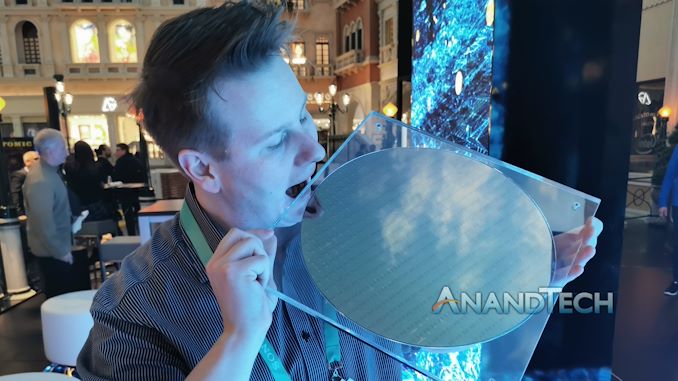

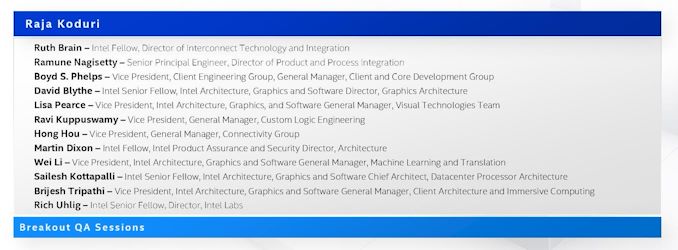
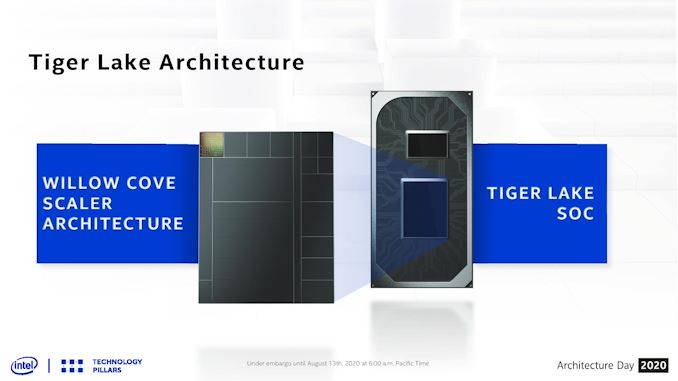
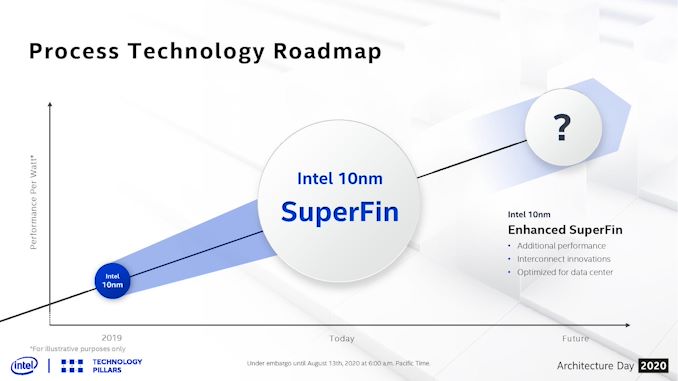
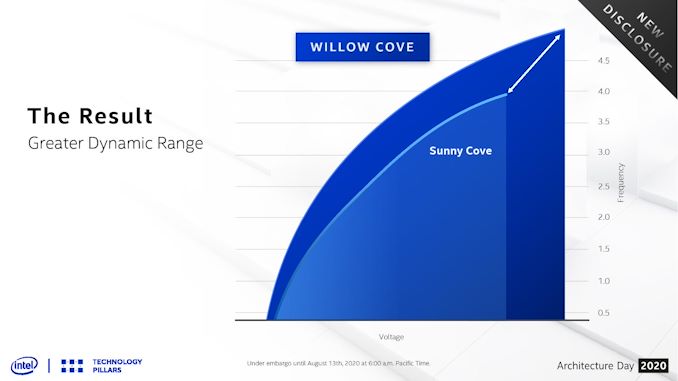








71 Comments
View All Comments
eastcoast_pete - Thursday, August 13, 2020 - link
Good news! Hope those announced products will actually ship this year, and not just in drip-drip-drip fashion. This will help keep Team Red on its toes, and that is good for all of us - as we learned during AMD's valley of tears, lack of competition means slower innovation and high prices.And, there is an actual chance those improvements are real; IMO, exhibit A for that is AMD has moved Cezanne's launch date earlier. Unless there is no real competition, why bother? They're barely able to ship enough Renoirs, so this suggests that AMD thinks these new Intel chips might be real, or real enough.
dullard - Thursday, August 13, 2020 - link
Which high prices are you talking about? Intel's top desktop processor, 2700K through 10700K all had about the same price, usually in the mid $300 range. The lack of AMD competition during the first half dozen years there didn't have almost any impact on price. When AMD was highly competitive at the 1 GHz race, prices were over $1000. There just isn't much impact on prices going from a monopoly to a duopoly.ZoZo - Thursday, August 13, 2020 - link
The high prices per core compared to how much cheaper those cores could have become with noteworthy competition. Also the high absolute prices of the many-core CPUs. Remember the HEDT platform CPU climbing up to $2000 and then the flagship 10th gen one (10980XE) introduced at half the price of the flagship 9th gen one (9980XE)? Sure AMD then went up to $4000 but the price per core is still much better than it was before Ryzen.Spunjji - Monday, August 17, 2020 - link
The high prices on that artificially-segmented category of "HEDT" for anyone who wanted more than 4 cores, perhaps? Or the fact that for those same prices you now get significantly more cores *and* more Ghz, which prior to the arrival of Ryzen was by no means guaranteed.You could also check the steadily-increasing prices of high-end laptops, where the lack of competition has been felt more keenly on both CPU and GPU fronts.
You're right that it doesn't drop things *that much* lower, but Intel have been delivering noticeable improvements in PP$ since AMD regained some semblance of competitiveness.
DannyH246 - Thursday, August 13, 2020 - link
WOW!!! More slides and paper talk from Intel!!! How exciting!shabby - Thursday, August 13, 2020 - link
Look at the bright side... it looks like they got a new person making those slides!Samus - Friday, August 14, 2020 - link
Hey, at least they are actually mass producing something on a new process!Jeff72 - Thursday, August 13, 2020 - link
So what would be the most efficient, lower core but highest clock rate CPU for desktop these days? I only would need maybe 4+ cores or so. I guess clock rate is more important to me but I also want low 10 nm process or lower for high efficiency. I'm only interested in air cooling also but want a quiet system overall. I feel so behind in my CPU knowledge these days. From what i've read, it seems AMD is doing very well these days. I'm currently running an Intel I7-4790K and have not felt the need to upgrade yet. Would like a huge bump in perceptible speed in general. I don't game much anymore but just want an overall fast and efficient and cool and quiet desktop replacement that could do gaming if I wanted to. What CPU is good now and what future CPU would be worth waiting for?fogifds - Thursday, August 13, 2020 - link
11th Gen Core for desktop looks really good. Rocket Lake architecture. Will be the last standard desktop CPU before Intel goes BIG.little core design like smartphones. Remains to be seen how Windows will deal with that.TouchdownTom9 - Thursday, August 13, 2020 - link
Not sure I really agree with you there. Rocket Lake looks to be a mediocre improvement over 10th gen. Still is going to be on 14nm (although they are backporting the micro arch from Ice/Tiger Lake). That is going to be challenged by AMD's Vermeer, which will be Zen 3 on a more advanced 7nm(EUV?) node with a unified cache, 8 core CCX, higher clocks, and a 15-20% IPC increase. That should hold the crown for the best chip lineup for your money when released in a few months. Gaming will be a close call (lets see the impact of an 8 core ccx), but unless Intel fundamentally changes their pricing scheme you will likely be able to get the 11th gen i7 for the same price as Ryzen 4900x (same for i5 vs R7). Not looking to be a fanboy for AMD (I'm impressed by what I've read about Tiger lake in this article), but AlderLake seems to be much more promising than Rocket Lake for Intel although yes it will be very interesting to see how the BIGlittle strategy is used by Windows. Just thought you might be overhyping Rocketlake and ignoring Vermeer.